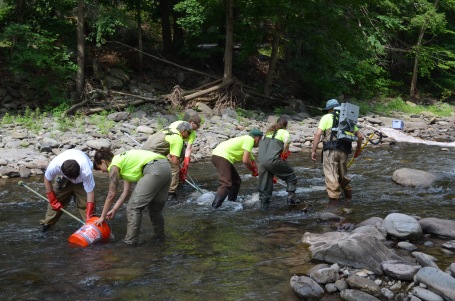Rainbow trout were first stocked in Esopus Creek in the Catskills in 1883, and pretty much ever since, the creek has been a rainbow stronghold.
Rainbows are common across New York, and a self-sustaining population of rainbows has flourished in the Delaware River for decades. Still, nowhere in New York has the rainbow dominated a stream so completely as the Esopus — until now.
For reasons that aren’t yet clear, the rainbows of the Esopus are losing ground to wild browns. Stream surveys in recent years by the Department of Environmental Conservation and the U.S. Geological Survey showed wild browns outnumbering rainbows.
“From 2009 to 2013 at our study sites, we see a steady decline in the number of rainbow trout,” said Scott George of Delmar, an ecology and evolutionary biology student at the University at Albany, studying trout habitat on the Esopus with the USGS.

A U.S. Geological Survey crew counts fish in Stony Clove Creek, a tributary of the Esopus, in July 2013. Morgan Lyle photo.
At four locations on the Esopus and five more on tributaries, the USGS team has counted fish for the past five years. Consider these preliminary findings, on a stream where historian
Austin McK. Francis once reported wild rainbows outnumbered wild browns 10 to 1:
In 2009, the USGS crew found 410 rainbows and 814 browns at the nine survey sites. In 2010, rainbows were back on top, though not by much — 428 ’bows, 331 browns. In 2011, there were 175 rainbows and 120 browns.
In 2012, the electrofishing crew found 147 rainbows, 962 browns. This summer, browns outnumbered rainbows, 441 to 59.
It’s an amazing turnaround — from 10-to-1 rainbows to 10-to-1 browns.
The USGS study is being finalized and will be formally released next year. The DEC, meanwhile, has been counting fish in the creek and in Ashokan Reservoir downstream, and it, too, has found a decline in rainbows.
Electrofishing two sites twice a year for the past four years, “in general, we saw fewer rainbow trout and more brown trout,” said Region 3 fisheries manager Michael Flaherty. “We also finished a three-year period of ‘season-long creel surveys in 2012.’ Over those three years, we saw what appears to be a greater proportion of the catch reported as ‘brown trout.’ This is different than what we saw in the early 1990s, when small rainbow trout were more commonly caught than brown trout.” Gill-netting in Ashokan Reservoir produced fewer rainbows than in the past, he said.
The DEC’s findings are also preliminary, with final results expected in the spring. The trend seems clear, but neither agency is ready to declare that browns have permanently overtaken rainbows on the Esopus.
“This is one little snapshot that says there may be a trend there, but we need to look at it from a lot of angles,” Flaherty said.
There’s nothing mysterious about the dominance of browns the past two seasons. We can thank Tropical Storm Irene for that.
The monster storm in late August 2011 left behind vast expanses of clean gravel that brown trout used for spawning a few weeks later. By the time the 2012 class of rainbows hatched out the following spring, the creek was full of young-of-the-year browns that out-competed them for food and habitat and probably ended up eating more than a few of them.
The trend, however, was in place before Irene. Then again, Irene was hardly the first big storm to impact the Esopus in recent times. Going back to 1996, the creek and the region have experienced numerous big storms, and the timing of such events can impact the success of year-classes, as in the fall of 2011 and spring of 2012.
Is climate change causing an increase in big-water events which have eroded the rainbow’s traditional dominance? Neither agency is prepared to make that claim, though both said it’s conceivable. The current decline of rainbows and rise of browns may also simply be a blip with no long-term significance.
There’s nothing wrong with catching wild brown trout, of course, but somehow it would be a little sad if the Esopus ceased to be a haven for beautiful, feisty, wild rainbows after 130 years.
